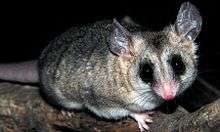Thylamys
Thylamys is a genus of opossums in the family Didelphidae. The premaxillae are rounded rather than pointed. The females lack a pouch. The females' nipples are arranged in two symmetrical rows on the abdomen.[2] All species but T. macrurus store fat in their tails.,[3] although this is not necessarily true for all species in the genus.[4]
| Thylamys[1] | |
|---|---|
 | |
| Elegant fat-tailed mouse opossum | |
| Scientific classification | |
| Kingdom: | Animalia |
| Phylum: | Chordata |
| Class: | Mammalia |
| Infraclass: | Marsupialia |
| Order: | Didelphimorphia |
| Family: | Didelphidae |
| Subfamily: | Didelphinae |
| Tribe: | Thylamyini |
| Genus: | Thylamys Gray 1843 |
| Type species | |
| Didelphis elegans Waterhouse 1839 | |
| Species | |
|
See text | |
Taxonomy
Extant species
The genus contains the following extant species:
- Cinderella fat-tailed mouse opossum (T. cinderella)
- (Thylamys citellus) [5]
- Elegant fat-tailed mouse opossum (T. elegans)
- (Thylamys fenestrae) [6]
- Karimi's fat-tailed mouse opossum (T. karimii)
- Paraguayan fat-tailed mouse opossum (T. macrurus) Olfers 1818
- White-bellied fat-tailed mouse opossum (T. pallidior) Thomas 1902
- (T. pulchellus) [7]
- Common fat-tailed mouse opossum (T. pusillus) Desmarest 1804
- Argentine fat-tailed mouse opossum (T. sponsorius)
- Tate's fat-tailed mouse opossum (T. tatei)
- Dwarf fat-tailed mouse opossum (T. velutinus)
- Buff-bellied fat-tailed mouse opossum (T. venustus) Thomas 1902
Fossil species
Fossils belonging to the genus date back to the Miocene, with the oldest specimens being found in the Cerro Azul Formation of Argentina and the Honda Group of Colombia.[8] Genetic studies indicate that the genus may have originated around 14 million years ago.[9]
Fossil species:[10]
- Thylamys colombianus Goin 1997
- Thylamys minutus Goin 1997
- Thylamys pinei Goin et al. 2000
References
- Gardner, A.L. (2005). "Order Didelphimorphia". In Wilson, D.E.; Reeder, D.M (eds.). Mammal Species of the World: A Taxonomic and Geographic Reference (3rd ed.). Johns Hopkins University Press. pp. 17–18. ISBN 978-0-8018-8221-0. OCLC 62265494.
- Eisenberg, John Frederick; Redford, Kent Hubbard (1999). Mammals of the Neotropics: The Central Neotropics: Ecuador, Peru, Bolivia, Brazil. University of Chicago Press. p. 624. ISBN 978-0-226-19542-1.
- Gardner, Alfred L. (2008). Mammals of South America: Marsupials, xenarthrans, shrews, and bats. University of Chicago Press. p. 669. ISBN 978-0-226-28240-4.
- Voss, R.S. & Jansa, S.A. (2003). "Nonmolecular data and new IRBP sequences: separate and combined analyses of didelphine relationships with denser taxon sampling". Bulletin of the American Museum of Natural History. 276: 1–82. doi:10.1206/0003-0090(2003)276<0001:PSODMI>2.0.CO;2. hdl:2246/444.
- Flores, D.; Teta, P. (2016). "Thylamys citellus". IUCN Red List of Threatened Species. 2016: e.T199835A22172943. doi:10.2305/IUCN.UK.2016-2.RLTS.T199835A22172943.en. Retrieved 9 January 2020.
- Martin, G.M.; Flores, D. (2016). "Thylamys fenestrae". IUCN Red List of Threatened Species. 2016: e.T199836A22172852. doi:10.2305/IUCN.UK.2016-2.RLTS.T199836A22172852.en. Retrieved 9 January 2020.
- Flores, D.; Teta, P. (2016). "Thylamys pulchellus". IUCN Red List of Threatened Species. 2016: e.T199834A22172571. doi:10.2305/IUCN.UK.2016-2.RLTS.T199834A22172571.en. Retrieved 9 January 2020.
- Braun, J.K.; et al. (2005). "Phylogenetic and biogeographic relationships of mouse opossums Thylamys (Didelphimorphia, Didelphidae) in southern South America". Journal of Mammalogy. 86 (1): 147–159. doi:10.1644/1545-1542(2005)086<0147:PABROM>2.0.CO;2.
- Steiner, C.; et al. (2005). "New DNA data from transthyretin nuclear intron suggest an Oligocene to Miocene diversification of living South American opossums (Marsupialia: Didelphidae)". Molecular Phylogenetics and Evolution. 35 (2): 363–379. doi:10.1016/j.ympev.2004.12.013. PMID 15804409.
- Thylamys at Fossilworks.org
This article is issued from Wikipedia. The text is licensed under Creative Commons - Attribution - Sharealike. Additional terms may apply for the media files.